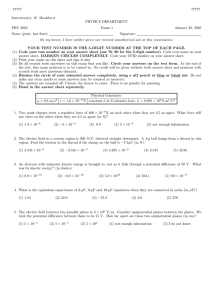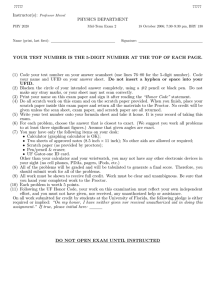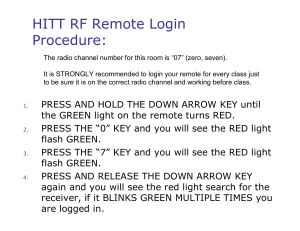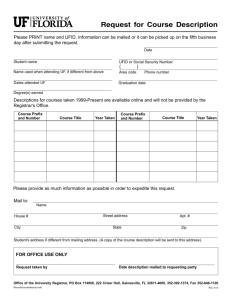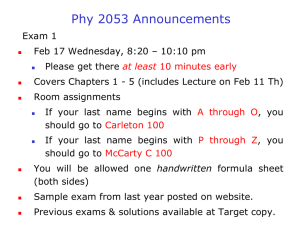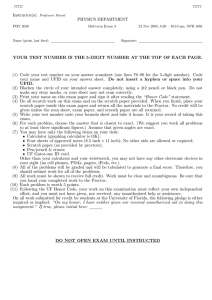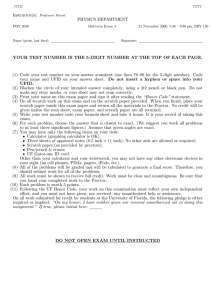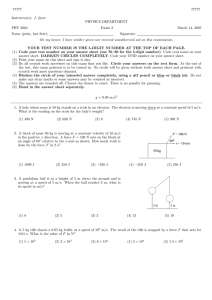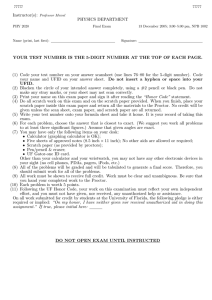Instructor(s): PHYSICS DEPARTMENT
advertisement
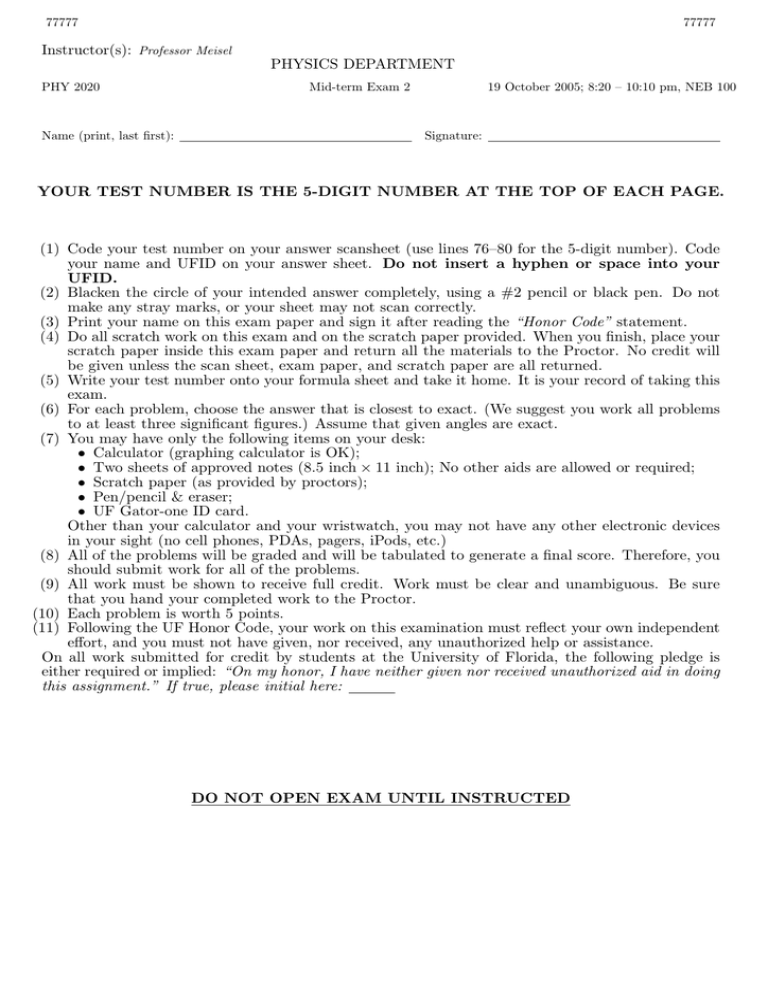
77777 77777 Instructor(s): Professor Meisel PHY 2020 Name (print, last first): PHYSICS DEPARTMENT Mid-term Exam 2 19 October 2005; 8:20 – 10:10 pm, NEB 100 Signature: YOUR TEST NUMBER IS THE 5-DIGIT NUMBER AT THE TOP OF EACH PAGE. (1) Code your test number on your answer scansheet (use lines 76–80 for the 5-digit number). Code your name and UFID on your answer sheet. Do not insert a hyphen or space into your UFID. (2) Blacken the circle of your intended answer completely, using a #2 pencil or black pen. Do not make any stray marks, or your sheet may not scan correctly. (3) Print your name on this exam paper and sign it after reading the “Honor Code” statement. (4) Do all scratch work on this exam and on the scratch paper provided. When you finish, place your scratch paper inside this exam paper and return all the materials to the Proctor. No credit will be given unless the scan sheet, exam paper, and scratch paper are all returned. (5) Write your test number onto your formula sheet and take it home. It is your record of taking this exam. (6) For each problem, choose the answer that is closest to exact. (We suggest you work all problems to at least three significant figures.) Assume that given angles are exact. (7) You may have only the following items on your desk: • Calculator (graphing calculator is OK); • Two sheets of approved notes (8.5 inch × 11 inch); No other aids are allowed or required; • Scratch paper (as provided by proctors); • Pen/pencil & eraser; • UF Gator-one ID card. Other than your calculator and your wristwatch, you may not have any other electronic devices in your sight (no cell phones, PDAs, pagers, iPods, etc.) (8) All of the problems will be graded and will be tabulated to generate a final score. Therefore, you should submit work for all of the problems. (9) All work must be shown to receive full credit. Work must be clear and unambiguous. Be sure that you hand your completed work to the Proctor. (10) Each problem is worth 5 points. (11) Following the UF Honor Code, your work on this examination must reflect your own independent effort, and you must not have given, nor received, any unauthorized help or assistance. On all work submitted for credit by students at the University of Florida, the following pledge is either required or implied: “On my honor, I have neither given nor received unauthorized aid in doing this assignment.” If true, please initial here: DO NOT OPEN EXAM UNTIL INSTRUCTED 77777 77777 1. In order to receive credit for this problem, you must correctly code (“bubble”) both your 8-digit UFID and your 5-digit test number onto your scan sheet and also select the correct response below. Check right now that both numbers are correctly bubbled. Code your UFID as if it were an ordinary 8-digit number and do not insert a blank space or hyphen in the middle. (1) (2) (3) (4) (5) I I I I I have correctly bubbled my UFID and test number. don’t think this is important. bubbled the wrong test number. don’t have time to check. bubbled the wrong UFID. 2. A 4,000 lb pick-up truck is coasting on a level road at a speed of 15 miles per hour. A 500 lb tree limb falls down into the bed of the truck. What is the speed of the truck with the limb? Neglect friction and state the answer in miles per hour. (1) 13.3 (2) 15.0 (3) 16.9 (4) 1.9 (5) 120 3. Suppose the mass of the earth and the mass of the moon were double their present values, and the distance between them tripled. By what factor would the force of gravity between them change? (1) 4 9 (2) 4 3 (3) 3 4 (4) 2 3 (5) None of these values are correct. 4. A centrifuge rotor has a moment of inertia of 5 × 10−3 kg m2 . How much energy is required to bring it from rest to 10,000 rpm? (1) 2.7 kJ (2) 27 J (3) 270 J (4) 26 J (5) 250 kJ 5. An I-beam made from recycled plastic soda bottles supports a 20,000 kg load, as shown in Figure 1. Assume the I-beam is massless. What are the magnitudes of F1 and F2 ? For the possible choices, F1 is listed first and F2 is listed second. (1) (2) (3) (4) (5) 65 kN, 131 kN 131 kN, 65 kN 100 kN, 100 kN 200 kN, 200 kN Not enough information is given to answer this question. 6. At a pressure of 1 bar, liquid nitrogen boils at a temperature of about 77◦ K. What is this temperature in ◦ F? (1) None of the values listed are correct. (2) −196.1 (3) −459.7 (4) −452.5 (5) −273.2 7. The maximum gauge pressure in a hydraulic lift is 20 bar. What is the largest mass that it can lift if the diameter of the output line is 30 cm? (1) 1.4 × 104 kg (2) 5.8 × 108 kg (3) 144 g (4) 5.8 × 103 kg (5) 600 kg 8. Professor Meisel used an “aluminum boat” to provide an estimate of the mass of a 1 Marka Finnish coin. His aluminum boat had a base of 5 cm by 4 cm, and the walls of the boat were 1 cm. This boat was floated in water, and it could handle 3 coins. However, when a fourth coin was added, the boat just barely sank. Based on this measurement, what is the estimate for the mass of the coin? You may wish to recall that water has a density of 1 g/cm3 . (1) 5 g (2) 1 g (3) 2 g (4) 3 g (5) 4 g 77777 77777 1 9. A uniform disk (I = M R2 ) of metal of mass M = 1.5 kg and radius R = 13.0 cm is initially at rest. Assume that 2 a force F is applied by a massless string, as shown in Figure 2, so the disk accelerates from 0 to 33.3 rpm in 2.0 seconds. What is F ? (1) 0.17 N (2) 1.27 N (3) 1.7 N (4) 0.15 N (5) Not enough information is given to answer. 10. (CONTINUATION) How many revolutions does the disk make in these two seconds? (1) 0.55 rev (2) 0.17 rev (3) 3.5 rev (4) 1.5 rev (5) 0.077 rev 11. What is the period (in minutes) of a satellite orbiting 100 km above the surface of the Earth? You may wish to know that the radius and the mass of the Earth are 6.4 × 103 km and 6 × 1024 kg, respectively. (1) 87 min (2) 92 min (3) 78 min (4) 83 min (5) None of the possible choices are correct. 12. Suppose you are a participant on Survivor: Physics in Gainesville. To win a challenge, you must construct a raft that will support your mass of 70 kg, and your raft must be constructed with the minimum number of coconuts. Assume the density the coconuts is 0.8 × 103 kg/m3 . Assume that each coconut has a volume of 0.01 m3 . How many coconuts do you need to use to win the challenge? Assume the density of water to be 1000 kg/m3 . (1) 35 (2) 16 (3) 42 (4) 10 (5) Not enough information given to answer. 13. A compressed gas cylinder contains Helium gas in a volume of 1.5 m3 under a pressure of 15 bar at 22 C. What volume will this gas occupy if it is allowed to expand, at constant temperature, until it reaches a pressure of 1 bar? (1) 22.5 m3 (2) 10.2 m3 (3) 330 m3 (4) 0.1 m3 (5) None of the possible choices are correct. 14. Last year, Typhoon Ma-on struck Japan with sustained wind speeds of 50 m/s. Assume that the average house near Tokyo has an area of 250 m2 . If these winds blow over the top of this house, what is the pressure difference across the roof? The density of air is 1.3 kg/m3 . (1) 1.6 kPa (3) 3.25 × 105 Pa (2) 1625 kPa (4) zero (5) 3.25 bar 15. Water towers are tall to provide pressure. Each foot of height provides a certain amount of pressure. What is this pressure in units of PSI (pounds per square inch)? You may want to recall that the density of water is 103 kg/m3 . (1) 0.43 (2) 32 (3) 9.8 (4) 2.2 (5) Not enough information is given to answer this question. 16. Consider a standard X-Y Cartesian grid system, where (x,y) notation provides the locations of different points. A mass of 4 kg is located at (0,2m). A mass of 2 kg is located at (1m,2m). A mass of 2 kg is located at (3m,0). The fourth and final mass of 4 kg is located at (−2m,−2m). What is the (X,Y) coordinates of the center of mass of this arrangement? 1 (1) (0, m) 3 (2) (0,0) 4 5 (3) ( m, m) 3 3 1 (4) (− m,0) 3 4 5 (5) (− m,− m) 3 3 17. A type of string breaks when it is under 250 N of tension. A fisherman uses this string to whirl a 2.5 kg weight in a horizontal circle of radius 2 m. The fisherman slowly and continuously increases the speed of the weight. At what speed will the string break? (1) 14 m/s (2) 500 m/s (3) 200 m/s (4) 200 rad/s (5) The correct value is not listed as an option. 77777 77777 18. A student stands near the center of a merry-go-round rotating at 0.25 rev/s. The student moves to the outer rim of the merry-go-round, and the rotations slows. By what factor has the student’s moment of inertia changed? (1) Not enough information is given to answer this question. (2) 1 2 (3) 1 3 (4) 1 4 (5) 1 10 19. Before deciding on a entry for Gator Can Nationals, Maria decided to calculate the linear speed of her can at the end of the ramp. Assume the can starts from rest and is 10 cm higher than it is at the end of the ramp. The can is 1 a solid cylinder, I = M R2 , of mass M = 0.5 kg and radius R = 3 cm. Neglect any frictional losses and assume the 2 can rolls without slipping. What is the speed of the can at the end of the ramp? (1) 1.1 m/s (2) 13 m/s (3) 0.5 m/s (4) 1.3 m/s (5) The correct value is not listed as an option. 20. A truck of mass 2500 kg is traveling North at 15 m/s and is approaching an intersection. A car of mass 1000 kg is traveling East at 37.5 m/s and is approaching the same intersection. The two vehicles collide inelastically. What is the velocity of the truck-car object immediately after the collision? (1) (2) (3) (4) (5) 15.15 m/s, 45◦ North of East 21.42 m/s, 45◦ North of East 15.15 m/s, 30◦ North of East 52.5 m/s, 67◦ North of East 22.5 m/s, 60◦ North of East 77777 77777 Figure 1 Figure 2
